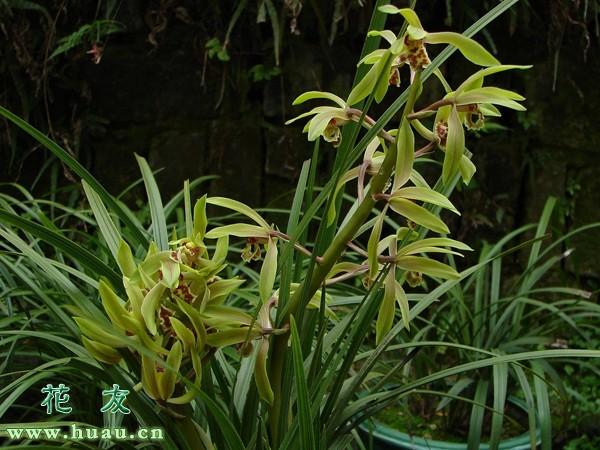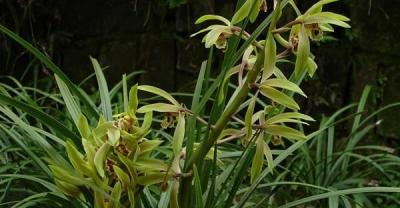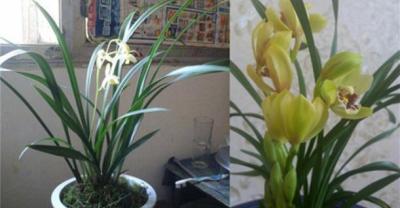Orchid: seven planting experiences of Orchid summarized by Orchid Farmer
New florists often ask about orchids. It just so happens that some flower friends often have the opportunity to get in touch with some orchid farmers, so they often have the nerve to ask others about their orchid raising experience, and brazenly argue that others have a good heart. In short, every time he sees the amiable Lannong grandfather, he always comes back with a full load. Oh, it's nice to talk. I feel like I can't bully an old man. I have tried these experiences by myself at home, and they are really useful, so I would like to share them with you:
1. It's not difficult to raise orchids without rotten roots. Don't make so many gaudy plants.
When I was a rookie in orchid farming, I had a big headache about what kind of plant material I used to change pots. Read a lot of books, read a lot of forums, but also collected a series of so-called plant materials, all kinds of mixing, all kinds of mixing … In the end, however, no matter what proportion or formula, the orchid root should be rotten, and to the last water, it is neither unwatered nor irrigated. Once I went to visit a friend in the orchid business. He took me to see an orchid farmer. I seized the opportunity and tried to get into other people's orchid houses. In fact, I just wanted to see what they used as planting materials. ! As a result, I saw that in his orchid house, which covers an area of more than a large warehouse, all orchids used only one kind of plant. I was messed up-- bark, he only used bark.
When I got home, I picked out all the dying orchids at home, emptied the plants inside, put a layer of stone at the bottom of the basin, and then planted them with a large piece of bark. A week later, green and tender new roots emerged, and from then on, I have confidence in orchids. Later, when trying to overdo the plant, disinfect the new plant, wrap it with a little water moss, then tie it to the wood and put it in the shaded orchid shed.
Grandpa Lannon said why not to use so many fancy plants. Because we rookies are afraid that orchids don't have enough water, so they are heavily watered, but in fact, orchids are more afraid of being too wet than dry ones. Although everyone knows that orchids are not dry or watered, what is dry for beginners? Presumably only a few years of experience is also difficult to master, because it is impossible to remove the plant material every time it is watered to see if it is dry, and the plant material is dry from the outside to the inside. Very often, when we see that the outer plant material is too dry, in fact, the plant material in the center is still wet, especially the plant material with water moss. No wonder the root inside is rotten if it is watered at this time.
So, learn honestly from your grandfather and use the bark.

2. Orchids don't blossom, most of which have nothing to do with fat.
After raising orchids over the past few years, the most strenuous one is Phalaenopsis. At first, it is a difficult problem. After conquering it, there is no challenge at all, so now we don't have a pot of Phalaenopsis in our collection. Many people must be like me, the first contact with orchids is from Phalaenopsis, and they must feel that Phalaenopsis is not easy to raise, because it never blossoms and never blossoms. One kind of thinking inertia is that if the plant does not blossom, it is because it is not fat enough. Then there is all kinds of fertilization, and then there are all kinds of burning roots, yellow leaves, and plant death. In fact, orchids are not plants that need to be fertilized. Think about their original state. On rocks and branches, very few orchids grow on the ground. Where do they get so much fertilizer? In fact, an important factor determining whether orchids draw pedicels or not is the temperature difference. The climate of the tropical rain forest is muggy and rainy, and the temperature difference between night and day is large, which is the reason for the orchid pedicel.
It is also very particular about fertilizing orchids. To be honest, I have not seen the orchid farmers here apply root fertilizer to orchids. Their fertilizers are all mixed with water and then sprayed regularly in the orchid house. It is best to do the same when applying fertilizer at home. Mix the compound fertilizer sprayed on the leaves with water and dilute it as much as possible. Don't be afraid of being too thin and thin. Then spray on the leaves to allow the orchid to absorb, preferably in the early morning or dusk, not at noon when the sun is bright, water the plant before fertilization, and so on when the plant is not dripping, do not pour the fertilizer into the basin, should be poured out, so as not to burn roots.
3. If you want the orchid to grow well, you can't like it too much.
I understand that many orchid lovers love their beloved orchids, and I love them so much that at first I can't put them down and touch the leaves and look at the flowers. I wish I could take them with me. As a result, my once favorite Phalaenopsis did not blossom for three years. Finally, it was no longer spoiled, and I put it in a corner of the orchid room, almost forgotten. Suddenly one day into the orchid room, a pedicel pulled out from the orchid heart, look at that sturdy son, must be a string of amazing flowers, the result is as expected. Therefore, I would like to advise the Orchid fans of Ailan not to move orchids all the time. Although the orchid is not demanding for the environment, it is extremely sensitive to environmental changes. A little change can make them nervous. As long as the orchid is scared, it is likely to refuse to blossom. If you think about it, even if you let a person travel all over the world every day, people can't stand it.
4. Do you want an orchid house or an orchid shed?
When I first started growing orchids, I didn't know how to create a good environment for orchids. I often hung them under a tree in the garden. as a result, the sun moved westward, always drying some orchids to death. Finally spent a lot of money, got an orchid house, at first very good, flowers grow cheerful, but before long the nightmare began. Orchids began to get sick, a variety of germs and insect pests, during that time almost every day to feed medicine, the result is still unable to recover. Later, he went to trouble to stir up the old man, and as soon as he heard what I said about the orchid house, he began to scold. It turned out that it was all caused by poor ventilation.
In fact, it is right to know how to provide a good environment for orchids, but too good environment will only be counterproductive. Although the orchid house is a high-cost and professional orchid equipment, it is really not needed for people who raise orchids to play with. But not sunshade can not, finally simply removed the plastic of the orchid shed, replaced with a black shading cloth, did not expect the effect is extremely good, orchids grow cheerful, there are few diseases.
5. Orchids need not much water, but dampness
What I want to talk about here is the problem of watering orchids. Many people know the basic principle of watering orchids-no dry, no water. However, there is no absolute standard for this degree of work. When most people buy flowers, they will ask the merchant a question: "how many days do you water?" What I want to say here is that don't completely believe what the merchants say. Businesses are just businessmen, most of them are not flower growers, and the answer they give is only a reference, even if they are flower growers, but because the environment at home is definitely not as good as that of other people's greenhouses, so the number of watering must be different.
For newly purchased orchids, if you see that the plant is still wet, don't water it first. The new orchid goes into the house and leaves it in a cool corner for two or three days. Let it calm down before watering it. When watering, do not drench the whole plant from high. From a relatively low height, use a relatively gentle flow of water to thoroughly water the orchid. The so-called watering does not mean that water leaks out of the basin bottom. As long as the orchid plant material is not made of soil, water will quickly leak out from the basin bottom, but this is not watering thoroughly. Let the orchid plant stay under the current for two to three minutes. Let the water in the orchid basin dry after the water is cut off, and it can be put back in place when it is not dripping. Do not sit the orchid in the basin in order to save trouble, it must be rotten.
When it's all right, you can spray water on the orchid plant several times a day, don't spray water in the sun, try not to leave water droplets on the leaves and flowers, so as not to cause burns, especially white flowers, very easy.
Spraying water is to increase air humidity, in fact, watering is not as reliable as humidification. Orchids will thank you very much for your efforts.
6. If orchids are unfortunately infected with germs, don't be distressed and kill them.
It is a very sad thing for beloved orchids to be infected by bacteria, because there is little chance that they can be saved, and even if they are saved, the orchid plant will be greatly damaged, and what is more terrible is that the bacterial infection will be contagious, especially the orchids of the same genus, which are most likely to be infected.
Well, if you want to treat it, it really takes a lot of work, so you have to wave your sword and give up in pain. Gather the diseased plants together-burn!
Don't wait for the flowers to blossom
Finally, the orchid blossomed, beautiful, looking really pleasing to the eye. Well, under normal circumstances, the flowering period of orchids can last for more than two weeks, but did you know that orchids will lose their vitality because of their flowering in the past few weeks, and in serious cases, they will not blossom in the next year? As a matter of fact, florists will cut off the flowers when the orchids bloom, but it doesn't make sense for us to do so, but we don't have to wait for the flowers to fade before cutting off the stamens. When the flowers are in the middle of blooming, they can cut them and put them in a bottle. It's just as beautiful. Just do not cut a scissors to low, leave a pedicel for the orchid plant to slowly recover nutrition, so as not to stimulate the orchid plant.
For more flower growing experience, succulent cultivation, bonsai appreciation, and communication with flower friends, please move to Huayu WeChat Community: http://m.huau.cn, or follow WeChat official account: huaucn.
- Prev

How to grow orchids? Culture methods and pest control of orchids
Orchids like shade, avoid direct sunlight, like moist, avoid drying, like fertile, rich in humus, good drainage, orchids like slightly acidic sandy loam. The temperature is 15.
- Next

Sharing the experience of orchid planting, how to grow orchids in the tenth month of the lunar calendar?
October Yangsheng heating back (Huiye Yun read) the following year, the bamboo shoots and pregnant jade roots are full of soil pots, especially in October of the lunar calendar, entering winter, it begins to be cold.
Related
- Is the orchid suitable for indoor use? Is it good for the body?
- How to prevent the empty root of orchids?
- What to do after the crab claw orchid is withered?
- Why are the leaves of orchids always yellow? Fertilizing and watering.
- Can the root of the gentleman orchid be saved if it is rotten?
- Diagnosis and treatment of cotton-blowing beetle insects in Cymbidium
- There is a way for a gentleman's orchid to rot.
- What is the most suitable temperature and humidity for the orchid?
- How to raise a gentleman's orchid? Cultivation techniques of Cymbidium
- How to prepare the nutritive soil for the cultivation of Cymbidium

